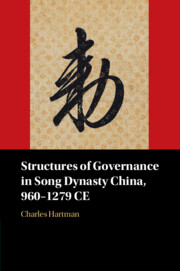Book contents
- Structures of Governance in Song Dynasty China, 960–1279 CE
- Structures of Governance in Song Dynasty China, 960–1279 CE
- Copyright page
- Contents
- Figures
- Tables
- Preface
- Notes on the Cover and on the Text
- Introduction
- Part I Dual Faces of the Song State
- 1 Gentlemen versus Petty Men
- 2 Virtue versus Talent
- 3 Inner versus Outer: The Politics of Political Space
- 4 Collective versus Unilateral Decision Making
- 5 The Technocratic–Confucian Continuum
- Part II The Technocratic and Confucian Models of Governance
- Part III Interactions
- Appendix of Senior Administration Positions, 1162–1182
- Bibliography
- Index
2 - Virtue versus Talent
from Part I - Dual Faces of the Song State
Published online by Cambridge University Press: 30 March 2023
- Structures of Governance in Song Dynasty China, 960–1279 CE
- Structures of Governance in Song Dynasty China, 960–1279 CE
- Copyright page
- Contents
- Figures
- Tables
- Preface
- Notes on the Cover and on the Text
- Introduction
- Part I Dual Faces of the Song State
- 1 Gentlemen versus Petty Men
- 2 Virtue versus Talent
- 3 Inner versus Outer: The Politics of Political Space
- 4 Collective versus Unilateral Decision Making
- 5 The Technocratic–Confucian Continuum
- Part II The Technocratic and Confucian Models of Governance
- Part III Interactions
- Appendix of Senior Administration Positions, 1162–1182
- Bibliography
- Index
Summary
Chapter 2 explains how the contrast between “virtue” (de, xian 德/賢) and “talent” (cai, neng 才/能) undergirded Song discourse on personnel management – on the qualities for recruitment into official service, on the nature of different career tracks within officialdom, and on the evaluation of official performance. This chapter includes a close reading of Emperor Xiaozong’s 孝宗 (1127–1194; r. 1162–1189) “A Discourse on Employing Officials” (Yongren lun 用人論), a tract that demonstrates how the monarchy resisted literati attempts to deploy the Confucian moral rhetoric of this dichotomizing discourse on virtue versus talent in order to challenge the emperor’s ultimate authority over personnel management. Abjuring the traditional equations between Confucians as virtuous junzi and technocrats as talented xiaoren, Chapters 1 and 2 analyze this rhetoric in preparation for thinking about concrete divisions in Song governmental practice that can be positioned along a technocratic–Confucian continuum.
Keywords
- Type
- Chapter
- Information
- Publisher: Cambridge University PressPrint publication year: 2023

